engine Acura NSX 2019 Manual Online
[x] Cancel search | Manufacturer: ACURA, Model Year: 2019, Model line: NSX, Model: Acura NSX 2019Pages: 485, PDF Size: 27.6 MB
Page 397 of 485
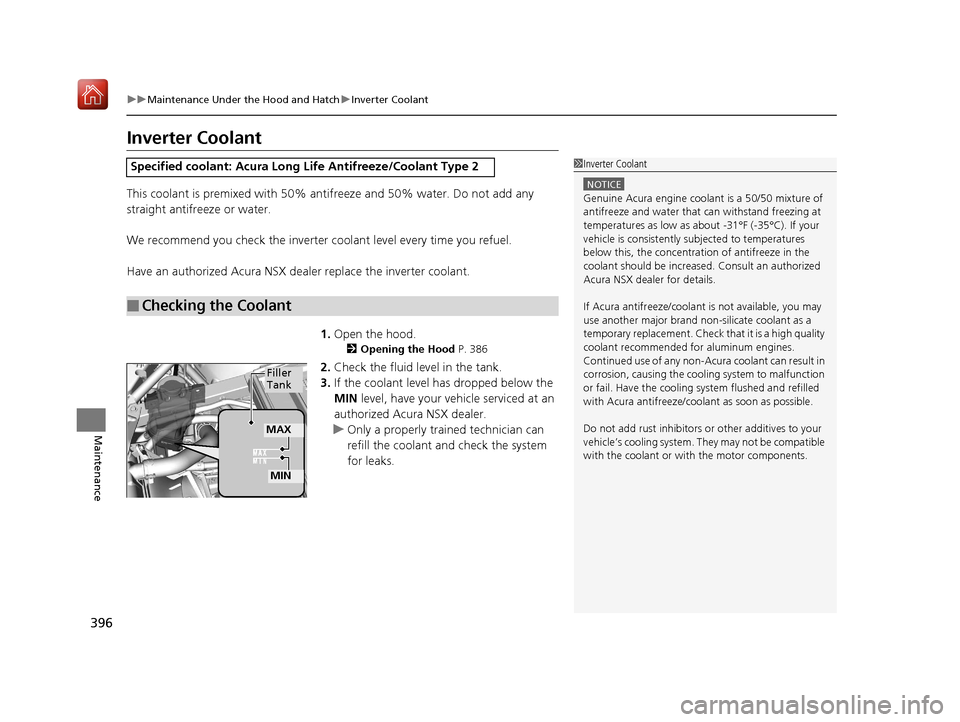
396
uuMaintenance Under the Hood and Hatch uInverter Coolant
Maintenance
Inverter Coolant
This coolant is premixed with 50% antifreeze and 50% water. Do not add any
straight antifreeze or water.
We recommend you check the inverter co olant level every time you refuel.
Have an authorized Acura NSX deal er replace the inverter coolant.
1. Open the hood.
2 Opening the Hood P. 386
2.Check the fluid level in the tank.
3. If the coolant level has dropped below the
MIN level, have your vehicle serviced at an
authorized Acura NSX dealer.
u Only a properly trained technician can
refill the coolant an d check the system
for leaks.
Specified coolan t: Acura Long Life Antifreeze/Coolant Type 2
■Checking the Coolant
1Inverter Coolant
NOTICE
Genuine Acura engine cool ant is a 50/50 mixture of
antifreeze and water that can withstand freezing at
temperatures as low as a bout -31°F (-35°C). If your
vehicle is consistently subjected to temperatures
below this, the concentration of antifreeze in the
coolant should be increased. Consult an authorized
Acura NSX dealer for details.
If Acura antifreeze/coolant is not available, you may
use another major brand non- silicate coolant as a
temporary replacement. Check that it is a high quality
coolant recommended fo r aluminum engines.
Continued use of any non-Acur a coolant can result in
corrosion, causing the cooling system to malfunction
or fail. Have the cooling system flushed and refilled
with Acura antifreeze/cool ant as soon as possible.
Do not add rust inhibitors or other additives to your
vehicle’s cooling system. They may not be compatible
with the coolant or with the motor components.
MAX
MIN
Filler
Tank
19 NSX-31T6N6200.book 396 ページ 2018年8月9日 木曜日 午前11時12分
Page 399 of 485
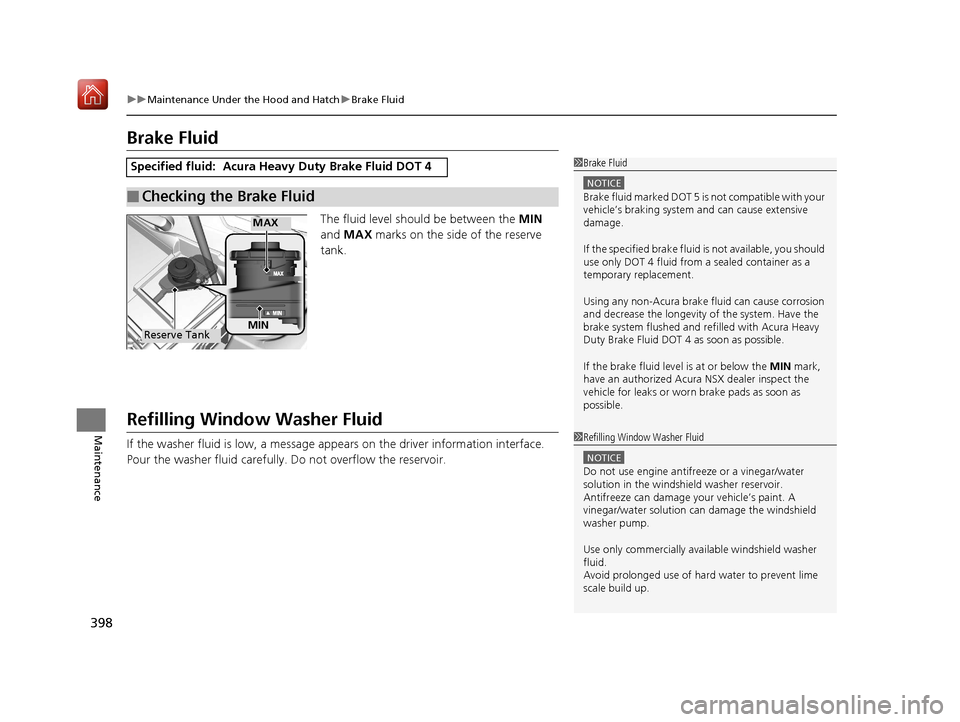
398
uuMaintenance Under the Hood and Hatch uBrake Fluid
Maintenance
Brake Fluid
The fluid level should be between the MIN
and MAX marks on the side of the reserve
tank.
Refilling Window Washer Fluid
If the washer fluid is low, a message ap pears on the driver information interface.
Pour the washer fluid carefully. Do not overflow the reservoir.
Specified fluid: Acura Heavy Duty Brake Fluid DOT 4
■Checking the Brake Fluid
1Brake Fluid
NOTICE
Brake fluid marked DOT 5 is not compatible with your
vehicle’s braking system and can cause extensive
damage.
If the specified brake fluid is not available, you should
use only DOT 4 fluid from a sealed container as a
temporary replacement.
Using any non-Acura brake fl uid can cause corrosion
and decrease the longevity of the system. Have the
brake system flushed and re filled with Acura Heavy
Duty Brake Fluid DOT 4 as soon as possible.
If the brake fluid level is at or below the MIN mark,
have an authorized Acura NSX dealer inspect the
vehicle for leaks or worn brake pads as soon as
possible.
MINReserve Tank
MAX
1 Refilling Window Washer Fluid
NOTICE
Do not use engine antifreeze or a vinegar/water
solution in the windshield washer reservoir.
Antifreeze can damage y our vehicle’s paint. A
vinegar/water solution ca n damage the windshield
washer pump.
Use only commercially avai lable windshield washer
fluid.
Avoid prolonged use of hard water to prevent lime
scale build up.
19 NSX-31T6N6200.book 398 ページ 2018年8月9日 木曜日 午前11時12分
Page 421 of 485
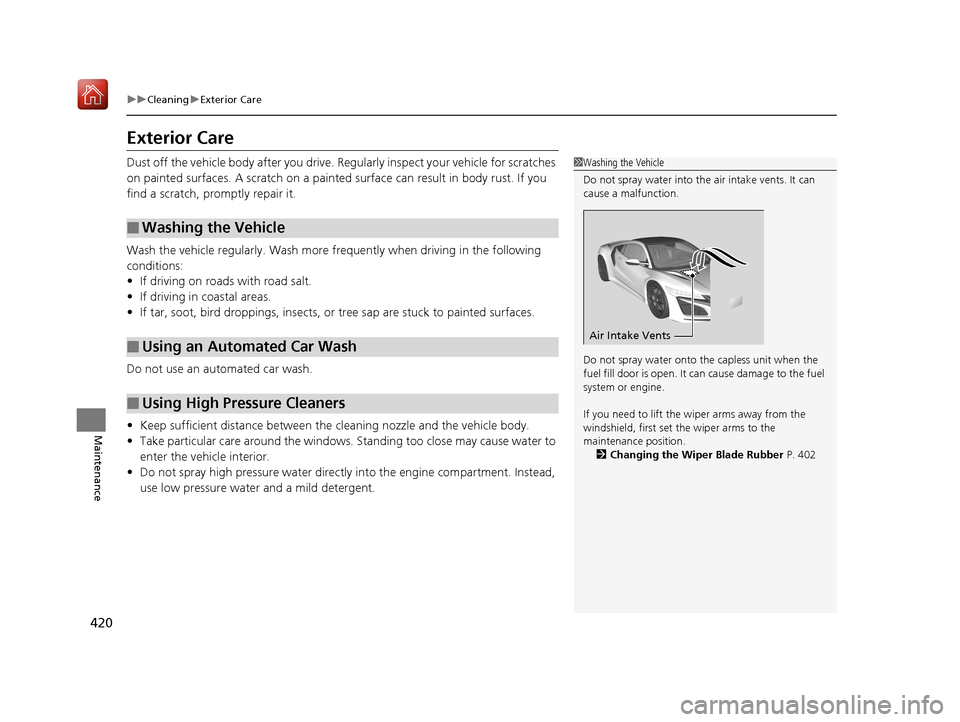
420
uuCleaning uExterior Care
Maintenance
Exterior Care
Dust off the vehicle body after you drive. Regularly inspect your vehicle for scratches
on painted surfaces. A scratch on a painted surface can result in body rust. If you
find a scratch, promptly repair it.
Wash the vehicle regularly. Wash more frequently when driving in the following
conditions:
• If driving on roads with road salt.
• If driving in coastal areas.
• If tar, soot, bird droppings, insects, or tree sap are stuck to painted surfaces.
Do not use an automated car wash.
• Keep sufficient distance between the cleaning nozzl e and the vehicle body.
• Take particular care around the windows. St anding too close may cause water to
enter the vehicle interior.
• Do not spray high pressure water directly into the engine compartment. Instead,
use low pressure water and a mild detergent.
■Washing the Vehicle
■Using an Automated Car Wash
■Using High Pressure Cleaners
1 Washing the Vehicle
Do not spray water into the air intake vents. It can
cause a malfunction.
Do not spray water onto the capless unit when the
fuel fill door is open. It ca n cause damage to the fuel
system or engine.
If you need to lift the wiper arms away from the
windshield, first set the wiper arms to the
maintenance position. 2 Changing the Wiper Blade Rubber P. 402
Air Intake Vents
19 NSX-31T6N6200.book 420 ページ 2018年8月9日 木曜日 午前11時12分
Page 422 of 485
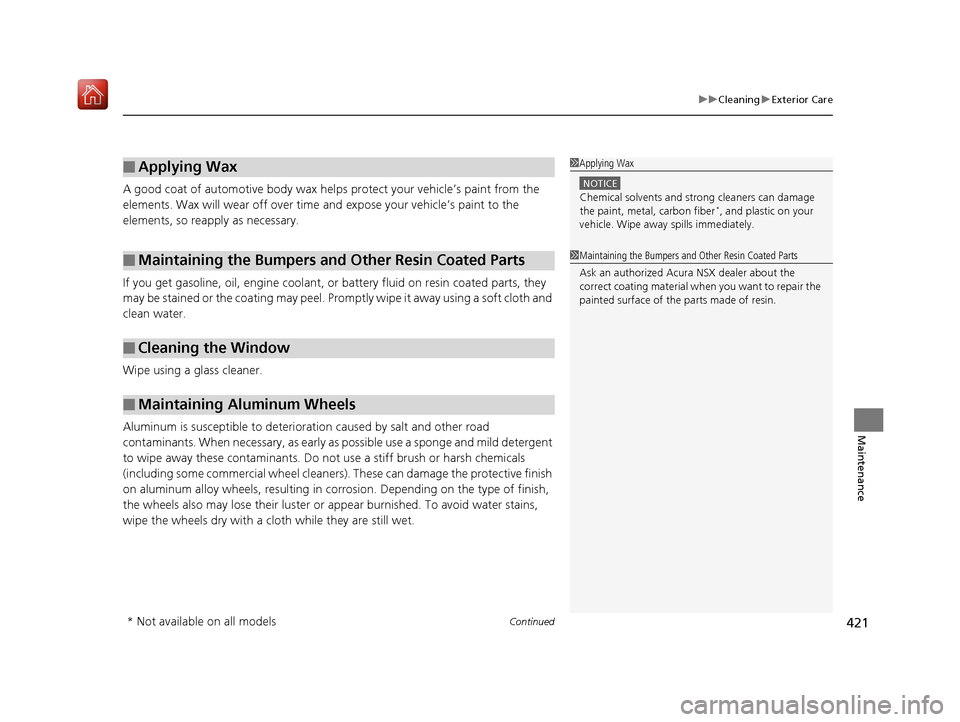
Continued421
uuCleaning uExterior Care
Maintenance
A good coat of automotive body wax helps protect your vehicle’s paint from the
elements. Wax will wear off over time and expose your vehicle’s paint to the
elements, so reapply as necessary.
If you get gasoline, oil, engine coolant, or battery fluid on resi n coated parts, they
may be stained or the coating may peel. Prom ptly wipe it away using a soft cloth and
clean water.
Wipe using a glass cleaner.
Aluminum is susceptible to deterioration caused by salt and other road
contaminants. When necessary, as early as possible use a sponge and mild detergent
to wipe away these contaminants. Do no t use a stiff brush or harsh chemicals
(including some commercial wheel cleaners). These can damage the protective finish
on aluminum alloy wheels, resulting in corrosion. Depending on the type of finish,
the wheels also may lo se their luster or appear burn ished. To avoid water stains,
wipe the wheels dry with a cloth while they are still wet.
■Applying Wax
■Maintaining the Bumpers and Other Resin Coated Parts
■Cleaning the Window
■Maintaining Aluminum Wheels
1 Applying Wax
NOTICE
Chemical solvents and st rong cleaners can damage
the paint, metal, carbon fiber*, and plastic on your
vehicle. Wipe away spills immediately.
1 Maintaining the Bumpers an d Other Resin Coated Parts
Ask an authorized Acur a NSX dealer about the
correct coating material when you want to repair the
painted surface of the parts made of resin.
* Not available on all models
19 NSX-31T6N6200.book 421 ページ 2018年8月9日 木曜日 午前11時12分
Page 425 of 485
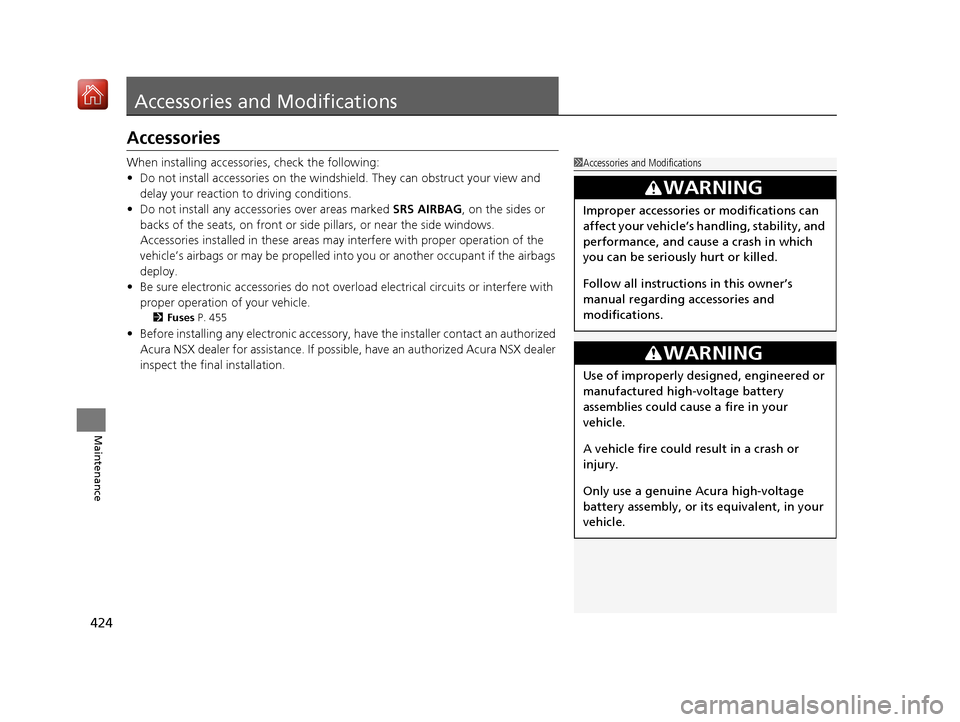
424
Maintenance
Accessories and Modifications
Accessories
When installing accessories, check the following:
• Do not install accessories on the windshield. They can obstruct your view and
delay your reaction to driving conditions.
• Do not install any access ories over areas marked SRS AIRBAG, on the sides or
backs of the seats, on front or side pillars, or near the side windows.
Accessories installed in these areas may interfere with proper operation of the
vehicle’s airbags or may be propelled into you or another occupant if the airbags
deploy.
• Be sure electronic accessories do not over load electrical circuits or interfere with
proper operation of your vehicle.
2 Fuses P. 455
•Before installing any electronic accessory, have the installer contact an authorized
Acura NSX dealer for assistance. If possibl e, have an authorized Acura NSX dealer
inspect the final installation.
1 Accessories and Modifications
3WARNING
Improper accessories or modifications can
affect your vehicle’s handling, stability, and
performance, and cause a crash in which
you can be seriously hurt or killed.
Follow all instruction s in this owner’s
manual regarding accessories and
modifications.
3WARNING
Use of improperly designed, engineered or
manufactured high-voltage battery
assemblies could cause a fire in your
vehicle.
A vehicle fire could result in a crash or
injury.
Only use a genuine Acura high-voltage
battery assembly, or it s equivalent, in your
vehicle.
19 NSX-31T6N6200.book 424 ページ 2018年8月9日 木曜日 午前11時12分
Page 426 of 485
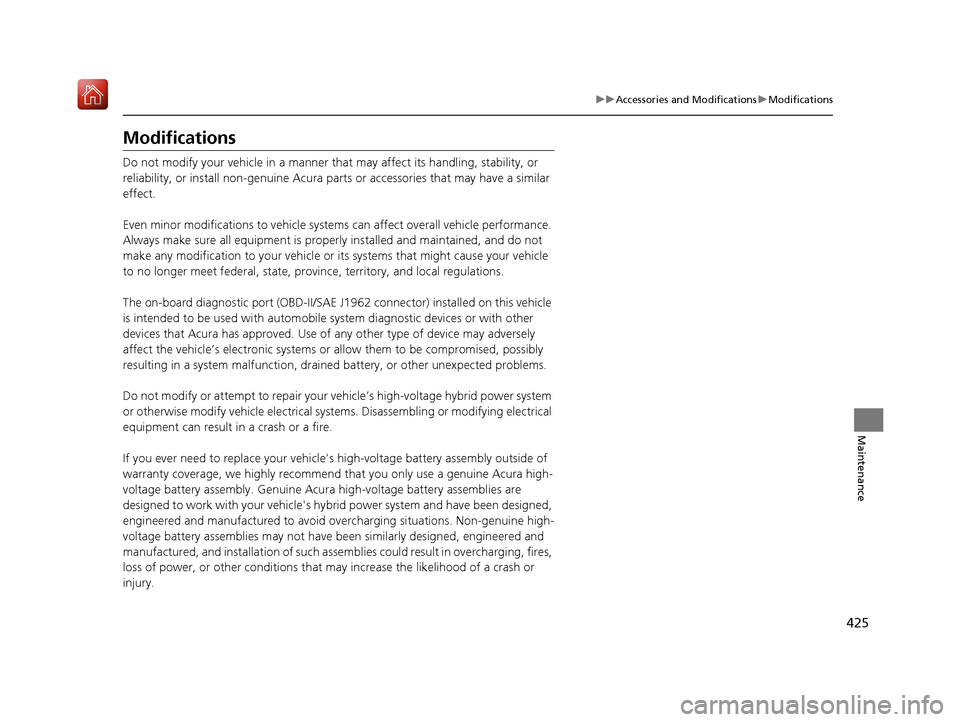
425
uuAccessories and Modifications uModifications
Maintenance
Modifications
Do not modify your vehicle in a manner that may affect its handling, stability, or
reliability, or install non-genuine Acura pa rts or accessories that may have a similar
effect.
Even minor modifications to vehicle systems can affect overall vehicle performance.
Always make sure all equipment is properly installed and maintained, and do not
make any modification to your vehicle or its systems that might cause your vehicle
to no longer meet federal, state, pr ovince, territory, and local regulations.
The on-board diagnostic port (OBD-II/SAE J1 962 connector) installed on this vehicle
is intended to be used with automobile system diagnostic devices or with other
devices that Acura has approved. Use of any other type of device may adversely
affect the vehicle’s electronic systems or allow them to be compromised, possibly
resulting in a system malfunction, drained battery, or other unexpected problems.
Do not modify or attempt to repair your vehicle’s high-voltage hybrid power system
or otherwise modify vehicle electrical syst ems. Disassembling or modifying electrical
equipment can result in a crash or a fire.
If you ever need to replace your vehicle' s high-voltage battery assembly outside of
warranty coverage, we highly recommend that you only use a genuine Acura high-
voltage battery assembly. Genuine Acura high-voltage battery assemblies are
designed to work with your vehicle's hybrid power system and have been designed,
engineered and manufactured to avoid overcharging situations. Non-genuine high-
voltage battery assemblies may not have b een similarly designed, engineered and
manufactured, and installation of such assemb lies could result in overcharging, fires,
loss of power, or other conditions that may increase the likelihood of a crash or
injury.
19 NSX-31T6N6200.book 425 ページ 2018年8月9日 木曜日 午前11時12分
Page 427 of 485
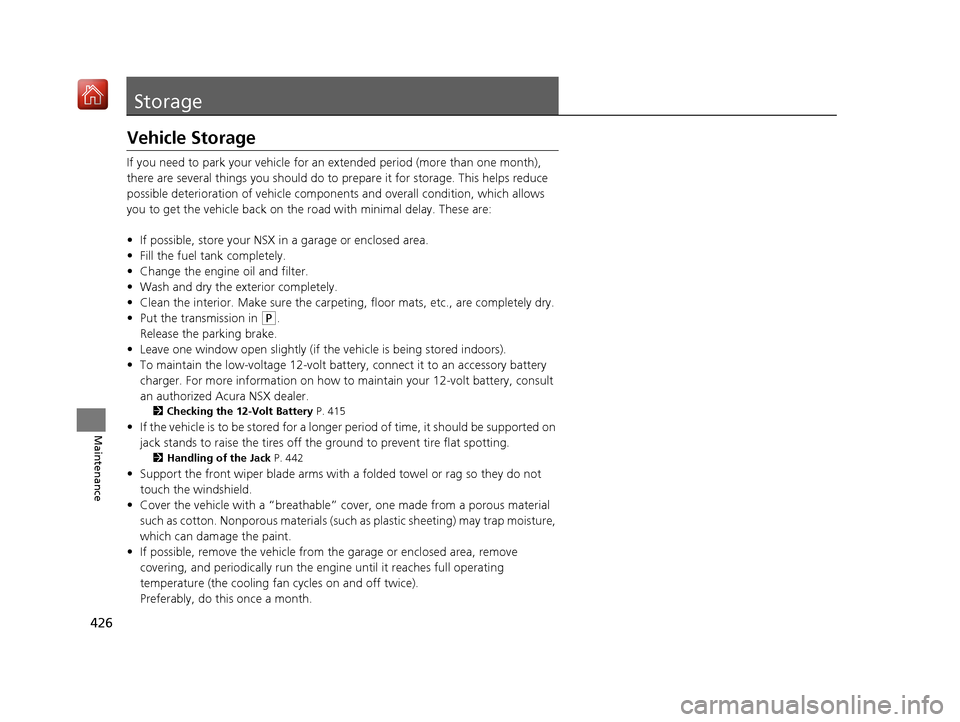
426
Maintenance
Storage
Vehicle Storage
If you need to park your vehicle for an extended period (more than one month),
there are several things you should do to prepare it for storage. This helps reduce
possible deterioration of vehicle components and overall condition, which allows
you to get the vehicle back on the road with minimal delay. These are:
• If possible, store your NSX in a garage or enclosed area.
• Fill the fuel tank completely.
• Change the engine oil and filter.
• Wash and dry the exterior completely.
• Clean the interior. Make sure the carpeti ng, floor mats, etc., are completely dry.
• Put the transmission in
(P.
Release the parking brake.
• Leave one window open slightly (if th e vehicle is being stored indoors).
• To maintain the low-voltage 12-volt battery, connect it to an accessory battery
charger. For more information on how to maintain your 12-volt battery, consult
an authorized Acura NSX dealer.
2 Checking the 12-Volt Battery P. 415
•If the vehicle is to be stored for a longer period of time, it should be supported on
jack stands to raise the tires off th e ground to prevent tire flat spotting.
2Handling of the Jack P. 442
•Support the front wiper blade arms with a folded towel or rag so they do not
touch the windshield.
• Cover the vehicle with a “breathable” co ver, one made from a porous material
such as cotton. Nonporous materials (suc h as plastic sheeting) may trap moisture,
which can damage the paint.
• If possible, remove the vehicle from th e garage or enclosed area, remove
covering, and periodically run the engi ne until it reaches full operating
temperature (the cooling fa n cycles on and off twice).
Preferably, do this once a month.
19 NSX-31T6N6200.book 426 ページ 2018年8月9日 木曜日 午前11時12分
Page 428 of 485
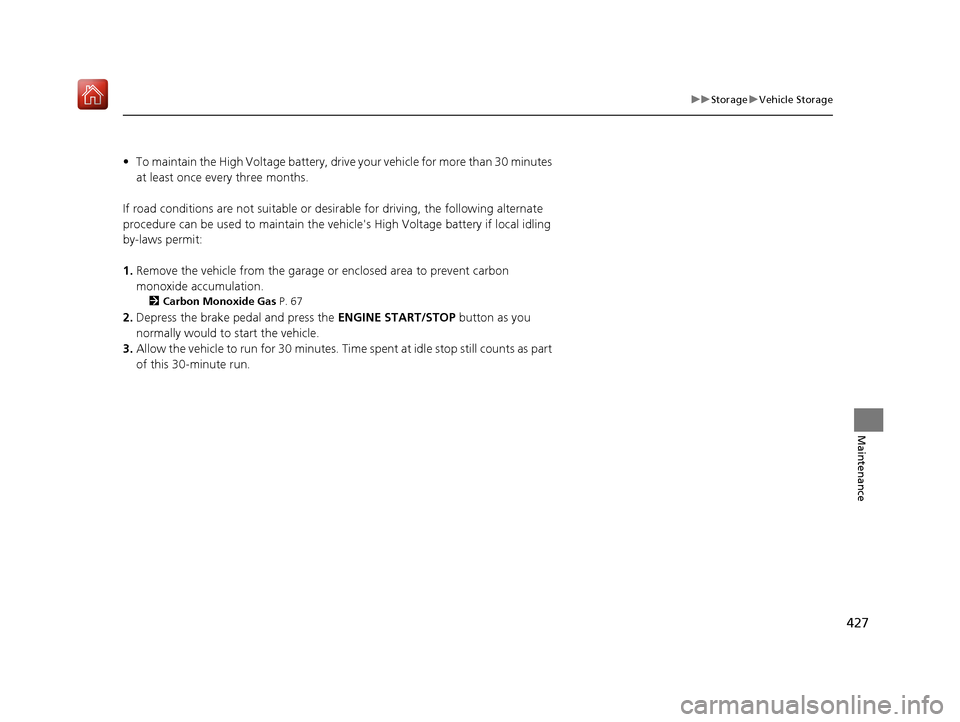
427
uuStorage uVehicle Storage
Maintenance
• To maintain the High Voltage battery, driv e your vehicle for more than 30 minutes
at least once every three months.
If road conditions are not suitable or de sirable for driving, the following alternate
procedure can be used to maintain the vehi cle's High Voltage battery if local idling
by-laws permit:
1. Remove the vehicle from the garage or enclosed area to prevent carbon
monoxide accumulation.
2 Carbon Monoxide Gas P. 67
2.Depress the brake pedal and press the ENGINE START/STOP button as you
normally would to start the vehicle.
3. Allow the vehicle to run for 30 minutes. Time spent at idle stop still counts as part
of this 30-minute run.
19 NSX-31T6N6200.book 427 ページ 2018年8月9日 木曜日 午前11時12分
Page 435 of 485
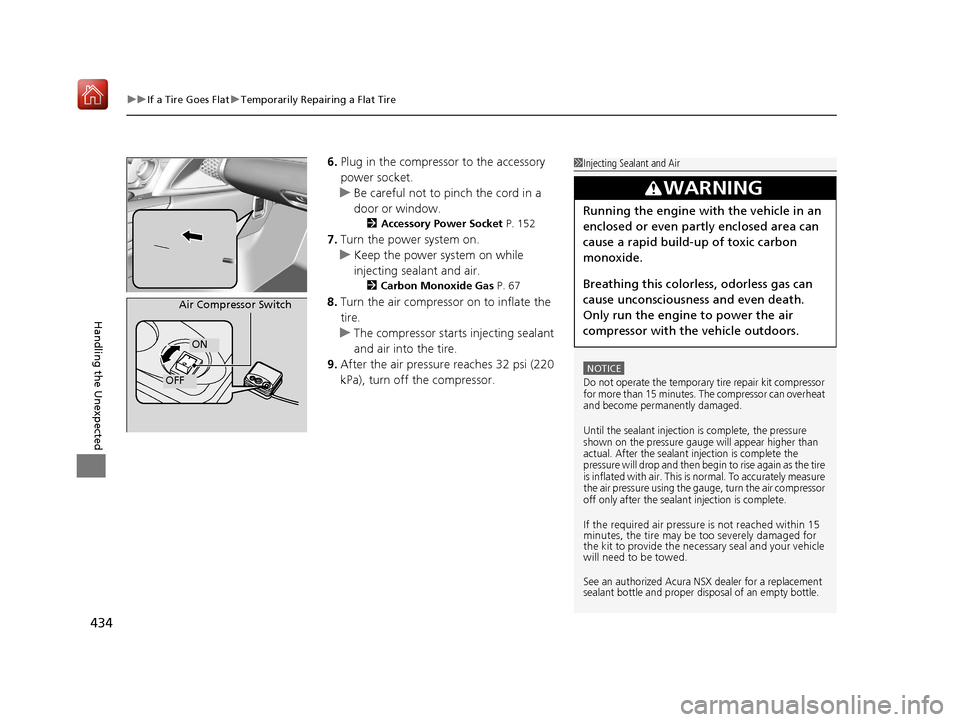
uuIf a Tire Goes Flat uTemporarily Repairing a Flat Tire
434
Handling the Unexpected
6. Plug in the compressor to the accessory
power socket.
u Be careful not to pinch the cord in a
door or window.
2 Accessory Power Socket P. 152
7.Turn the power system on.
u Keep the power system on while
injecting sealant and air.
2 Carbon Monoxide Gas P. 67
8.Turn the air compressor on to inflate the
tire.
u The compressor starts injecting sealant
and air into the tire.
9. After the air pressure reaches 32 psi (220
kPa), turn off the compressor.
1Injecting Sealant and Air
NOTICE
Do not operate the temporary tire repair kit compressor
for more than 15 minutes. The compressor can overheat
and become permanently damaged.
Until the sealant injection is complete, the pressure
shown on the pressure gauge will appear higher than
actual. After the sealant injection is complete the
pressure will drop and then begi n to rise again as the tire
is inflated with air. This is normal. To accurately measure
the air pressure using the ga uge, turn the air compressor
off only after the sealan t injection is complete.
If the required air pressure is not reached within 15
minutes, the tire may be too severely damaged for
the kit to provide the necessa ry seal and your vehicle
will need to be towed.
See an authorized Acura NSX dealer for a replacement
sealant bottle and proper disposal of an empty bottle.
3WARNING
Running the engine with the vehicle in an
enclosed or even partly enclosed area can
cause a rapid build-up of toxic carbon
monoxide.
Breathing this colorless, odorless gas can
cause unconsciousness and even death.
Only run the engine to power the air
compressor with th e vehicle outdoors.
Air Compressor Switch
OFF
ON
19 NSX-31T6N6200.book 434 ページ 2018年8月9日 木曜日 午前11時12分
Page 439 of 485
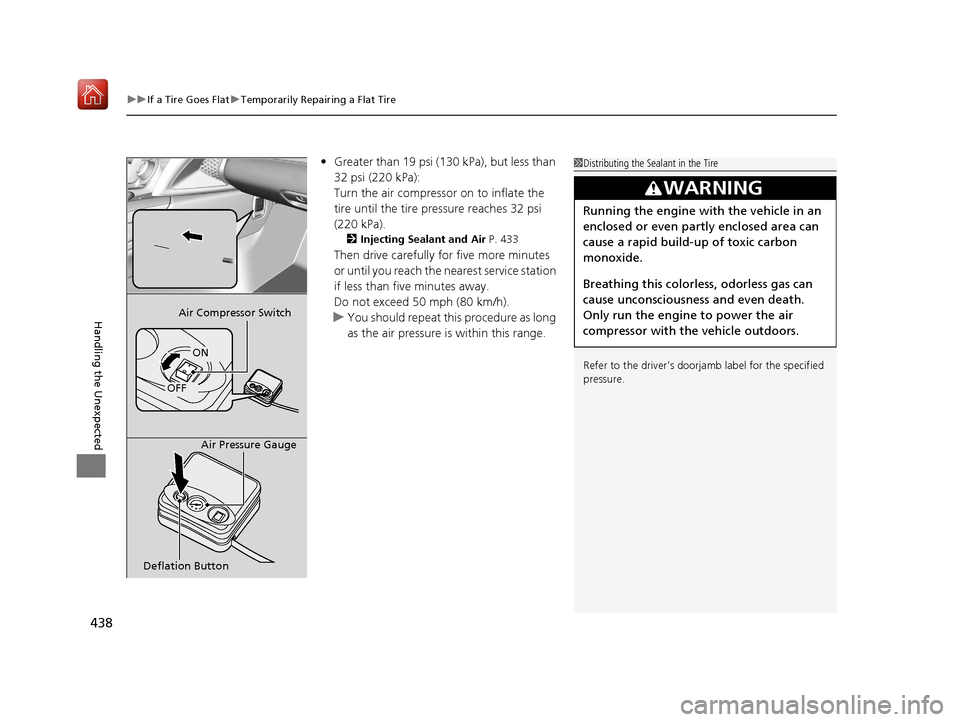
uuIf a Tire Goes Flat uTemporarily Repairing a Flat Tire
438
Handling the Unexpected
• Greater than 19 psi (130 kPa), but less than
32 psi (220 kPa):
Turn the air compressor on to inflate the
tire until the tire pressure reaches 32 psi
(220 kPa).
2 Injecting Sealant and Air P. 433
Then drive carefully for five more minutes
or until you reach the nearest service station
if less than five minutes away.
Do not exceed 50 mph (80 km/h).
u You should repeat this procedure as long
as the air pressure is within this range.
1Distributing the Sealant in the Tire
Refer to the driver’s doorja mb label for the specified
pressure.
3WARNING
Running the engine with the vehicle in an
enclosed or even partly enclosed area can
cause a rapid build-up of toxic carbon
monoxide.
Breathing this colorless, odorless gas can
cause unconsciousness and even death.
Only run the engine to power the air
compressor with th e vehicle outdoors.
Deflation ButtonAir Pressure Gauge
Air Compressor Switch
OFF
ON
19 NSX-31T6N6200.book 438 ページ 2018年8月9日 木曜日 午前11時12分